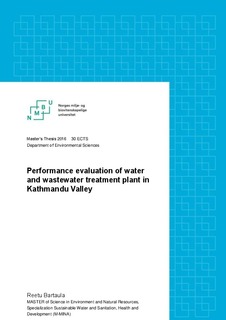| dc.contributor.advisor | Jenssen, Petter D. | |
| dc.contributor.advisor | Amatya, Iswar Man | |
| dc.contributor.author | Bartaula, Reetu | |
| dc.coverage.spatial | Katmandu | nb_NO |
| dc.date.accessioned | 2016-11-17T13:09:10Z | |
| dc.date.available | 2016-11-17T13:09:10Z | |
| dc.date.issued | 2016-11-17 | |
| dc.identifier.uri | http://hdl.handle.net/11250/2421608 | |
| dc.description.abstract | In this work, assessments of technology of the water and wastewater treatment plants including constructed wetlands in Kathmandu valley are presented. There are nine water treatment plants among which two are not in operation; seven constructed wetlands among which two are under maintenance and one is not in operation. In addition, one conventional wastewater treatment plant is studied in order to highlight the associated benefits and identify challenges of water and wastewater treatment in Kathmandu valley.
A constructed wetland uses less energy to treat wastewater than a conventional wastewater treatment plant. Thus, wetland systems have benefit in a country where energy scarcity occurs. However the technical and managerial problems and lack of awareness decrease the success of the wetland systems, but technical as well as managerial problems exist also in water treatment plants even Kathmandu Upatyaka Khanepani Limited (KUKL) has responsibility over it.
Analysis of chemical parameters that indicate the characteristics of wastewater from constructed wetlands is done by collecting one sample for each parameter. Similarly, assessment of technical and operation and maintenance for water and wastewater treatment plants including constructed wetlands are obtained by field observation and conducting questionnaire survey. Interviews with care operator are made for all studied treatment locations and reviews from user committees, non- user committees and farmers are made only for constructed wetlands.
A comparative analysis between conventional wastewater treatment plants and constructed wetland is also presented. Compared to conventional wastewater treatment systems, constructed wetland systems uses less energy and are less costly as well as easier to maintain due to simple construction and efficient functioning. More attention has given to water treatment plants though it does not show good performance in operation when compared to wastewater treatment plants.
The results showed that there is a need of development in water and wastewater management with systematic operation and maintenance. An effective study of the most fruitful type of plants and their monitoring after establishment is essential. Treatment efficiency of water and wastewater treatment plants has not shown very high performance. It is necessary to address issues, including economical, technical, social and personal to improve the systems. | nb_NO |
| dc.language.iso | eng | nb_NO |
| dc.publisher | Norwegian University of Life Sciences, Ås | |
| dc.rights | Navngivelse-Ikkekommersiell-IngenBearbeidelse 3.0 Norge | * |
| dc.rights.uri | http://creativecommons.org/licenses/by-nc-nd/3.0/no/ | * |
| dc.subject | Performance evaluation, water and wastewater treatment plant, constructed wetlands | nb_NO |
| dc.title | Performance evaluation of water and wastewater treatment plant in Kathmandu Valley | nb_NO |
| dc.type | Master thesis | nb_NO |
| dc.source.pagenumber | 118 | nb_NO |
| dc.description.localcode | M-MINA | nb_NO |

